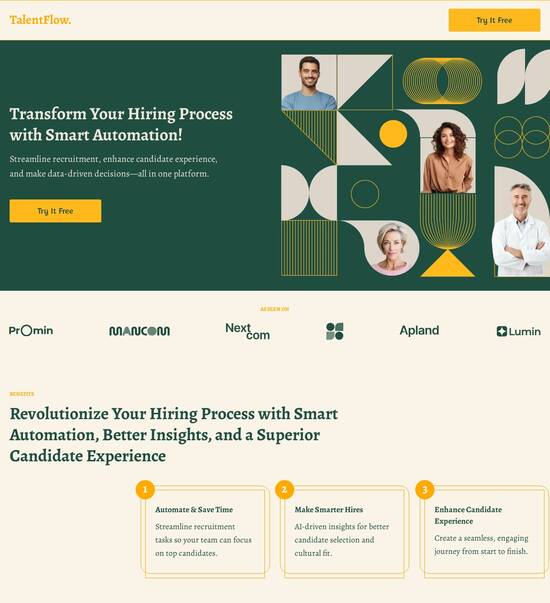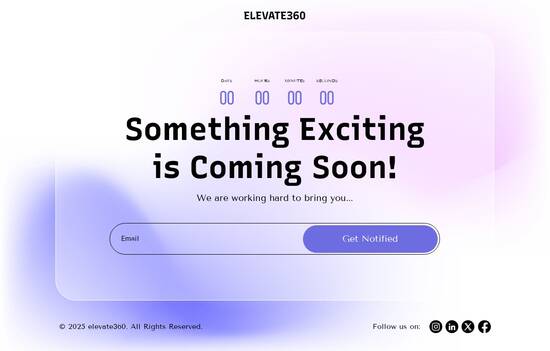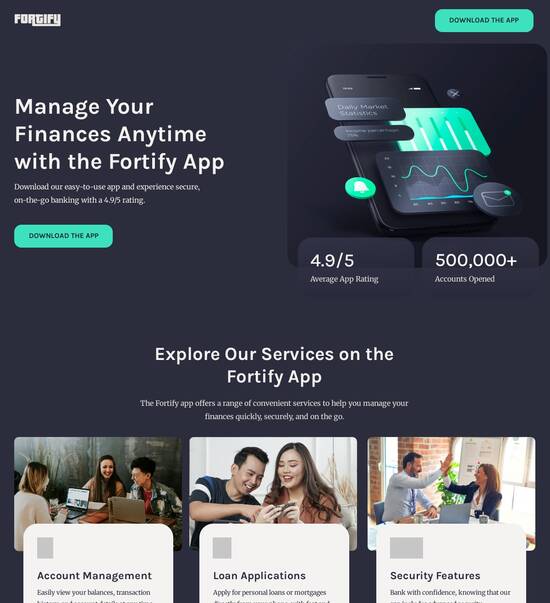
Bootstrap optimized help page template
Explore Similar TemplatesAbout template
Supercharge your help page with Bootstrap for outstanding performance! Learn more today.
Recommended templates

Easy to build without coding
With the intuitive drag-and-drop builder, anyone on your team can create high-converting pages without any knowledge of code or design. Make enhancements to your landing page with custom widgets using Javascript, HTML/CSS, or third-party scripts.

Multiple layouts for any industry and goal
Select from 500+ landing page layouts built to boost conversions across industry-specific scenarios. Customize them by adjusting fonts, adding images, and generating on-brand content with the AI assistant. Quickly scale with Instablocks® and Global Blocks that you can save, reuse, and update globally.

Loads fast and looks polished on any device
Every template is responsive, which means they present professionally on any device and load blazingly fast with our Thor Render Engine. You can also power them up with Google AMP technology to deliver an unparalleled mobile experience and drive higher conversions.

Robust analytics & experimentation
Get real-time updates and reporting across all your devices, showing the number of visitors, conversions, cost-per-visitor, and cost-per-lead. Launch AI-powered experiments, run A/B tests, and use heatmaps to analyze user behavior, then optimize your landing page to maximize conversions.







Easy to build without coding
With the intuitive drag-and-drop builder, anyone on your team can create high-converting pages without any knowledge of code or design. Make enhancements to your landing page with custom widgets using Javascript, HTML/CSS, or third-party scripts.
Multiple layouts for any industry and goal
Select from 500+ landing page layouts built to boost conversions across industry-specific scenarios. Customize them by adjusting fonts, adding images, and generating on-brand content with the AI assistant. Quickly scale with Instablocks® and Global Blocks that you can save, reuse, and update globally.
Loads fast and looks polished on any device
Every template is responsive, which means they present professionally on any device and load blazingly fast with our Thor Render Engine.
Robust analytics & experimentation
Get real-time updates and reporting across all your devices, showing the number of visitors, conversions, cost-per-visitor, and cost-per-lead. Launch AI-powered experiments, run A/B tests, and use heatmaps to analyze user behavior, then optimize your landing page to maximize conversions.
All the features you need to build create bootstrap template
Explore more featuresLearn how to build bootstrap review template
Frequently asked questions about bootstrap faq example
Leading the way in building high-performing landing pages





A complete guide to mastering instapage for effective landing page creation
Creating high-converting landing pages is essential for marketers aiming to boost the effectiveness of their campaigns. Instapage stands as an exemplary platform, enabling you to accelerate results through its robust suite of features designed for optimization and ROI maximization.
Understanding the importance of landing pages
Landing pages serve as crucial touchpoints in your marketing funnels, specifically tailored to convert visitors into leads or customers. When crafted effectively, they enhance user experiences and significantly influence conversion rates. Here’s why landing pages should be a staple in your digital marketing strategy:
- Focused messaging: Landing pages enable marketers to tailor content specifically to target audience needs, increasing relevance and engagement.
- Improved tracking: With distinct landing pages, you can better assess user interactions and campaign performance, driving data-informed decisions.
- Higher conversion rates: Well-designed landing pages can drastically improve conversion rates, turning visitors into potential customers.
Step 1: Leveraging instapage templates and lead generation elements
Instapage offers over 100 high-converting templates designed for various industries. These templates not only save time but allow for customization that meets your unique campaign needs:
- Quick setup: Select a template that aligns with your goals and modify it effortlessly using intuitive builders.
- Responsive design: Ensure that your landing pages look great on all devices, enhancing user experience for mobile users.
- Lead generation tools: Integrate lead capture forms and elements to facilitate data collection and engagement.
Step 2: Optimizing landing pages for maximum conversions
Optimization is key to ensuring your landing pages perform at their best. Utilize the built-in experimentation features provided by Instapage:
- A/B testing: Conduct tests to compare variations of your landing pages and determine the most effective elements.
- Heatmaps: Analyze user behavior on your pages, understanding where visitors click and how they navigate.
- Analytics dashboard: Leverage real-time data to assess performance metrics and make adjustments to enhance conversion rates.
Step 3: Personalizing content for different audiences
Personalization plays a significant role in enhancing user engagement. Instapage allows you to create tailored experiences for diverse audience segments:
- Dynamic text replacement: Customize content automatically based on user data to create a vital connection.
- AdMaps: Align specific advertisements to unique landing pages for cohesively targeted campaigns.
- Audience-level metrics: Track and optimize performance based on specific demographics for more insightful analytics.
By harnessing these steps effectively, marketers can transform their campaigns and drive tangible results using Instapage.
Ready to enhance your digital marketing strategy? Start utilizing Instapage now to create landing pages that convert!
People also ask about Bootstrap optimized help page template
Bootstrap optimized help page template: A guide to enhancing user experience
Understanding Bootstrap: The framework that powers modern web design
Bootstrap is an open-source front-end framework that streamlines the process of developing responsive, mobile-first websites. Its significance in web development cannot be overstated; it provides a robust structure for building dynamic web applications efficiently. By utilizing a grid system and pre-styled components, Bootstrap enables developers to create visually appealing websites that function seamlessly across a variety of devices.
Key features of Bootstrap enhance responsive design significantly. Features such as the flexible grid system adjust dynamically to different screen sizes, ensuring users have a consistent experience whether they’re using a desktop, tablet, or mobile device. Additionally, Bootstrap's built-in styles for typography, buttons, tables, and forms provide developers with a toolkit to create professional-looking web pages without needing to write extensive CSS.
Integrating Bootstrap into various web projects is straightforward. With a simple setup, developers can easily incorporate Bootstrap into their existing projects by linking to its CSS and JavaScript files or using a Content Delivery Network (CDN). This flexibility allows businesses of all sizes to leverage Bootstrap’s capabilities for a polished web presence.
The essence of a help page: A critical component of user experience
A help page plays a vital role in user engagement by providing a resource for users facing difficulties. When users seek help, it’s often due to confusion or the need for clarification regarding features or services. A well-structured help page not only offers solutions but also builds trust by demonstrating that a company values its customers’ experience.
Understanding why users seek assistance is crucial for designing an effective help page. Users might be looking for answers to specific questions, guidance on navigating the website, or troubleshooting information for issues they are experiencing. The impact of effective help pages on overall user experience cannot be underestimated; they can significantly reduce frustration and increase user satisfaction.
Core features of the Bootstrap optimized help page template
Responsive grid system
Bootstrap's responsive grid system is the backbone of its layout capabilities. It allows developers to create fluid layouts that adjust automatically to the width of the device screen. This feature is essential for help pages, as users may access them from various devices, including smartphones and tablets. The grid system enables effective spacing and alignment, ensuring that content is presented in an easily digestible format.
Utilizing the grid for different devices and screen sizes enhances usability. Developers can define how content is displayed across various platforms with simple class assignments, ensuring that the layout remains aesthetically pleasing and functional regardless of device.
Component-rich layouts
The template benefits from Bootstrap's vast library of components, such as buttons, cards, and modals. These components provide various elements that can enhance user interaction on help pages. For example, buttons can direct users to FAQs or tutorial videos, while cards can organize various topics or issues effectively.
Leveraging these components effectively allows developers to create a more interactive experience for users, guiding them through the help content with ease.
CSS customization
Tailoring the appearance of help pages through CSS is essential for maintaining brand consistency. Although Bootstrap provides a solid foundation, developers can customize styles to align with unique branding. This level of personalization not only enhances the visual appeal but also reinforces brand identity.
Best practices for maintaining consistency with branding include choosing a color palette that reflects the brand, utilizing consistent typography, and ensuring that elements follow a unified design language.
Structuring help page content: Sections that enhance clarity
To optimize the user experience, it’s crucial to include key sections in a help page layout. Commonly found segments include Frequently Asked Questions (FAQs), step-by-step guides, and contact information for further assistance. Well-organized content helps users quickly find what they need without overwhelming them.
Frequently Asked Questions (FAQs): Address common queries to save users time.
Step-by-step guides: Provide comprehensive instructions accompanied by visuals.
Contact information: Offer users a direct line for additional assistance.
The importance of keyword entry for searchability cannot be overlooked. Users often search for specific terms to find answers. Including relevant keywords in the help documents enhances the likelihood of appearing in search results, making it easier for users to locate information.
Utilizing tags for better organization and navigation enhances usability as well. This feature allows users to filter content efficiently and find the information they seek without unnecessary hassle.
User-centered design: Creating an intuitive help page experience
Understanding user behavior and expectations on help pages is fundamental. Users come with a specific problem they want to resolve. Consequently, the design must cater to their needs through an intuitive layout and accessible information. An overview of user feedback helps in refining help content continuously.
Tools for gathering user feedback can include surveys, feedback forms, or usability tests. These methods provide insights into how users interact with the page and what areas may need improvement. By acting upon this feedback, companies can ensure that their help pages are not only useful but also user-friendly.
The role of navigation and clarity cannot be overstated when it comes to user support experience. Easy-to-find help sections and a straightforward layout can significantly enhance user navigation, thus reducing user frustration and support inquiries.
Multi-device optimization: Ensuring accessibility across platforms
A mobile-first approach in help page design is vital, given the increasing number of users accessing content on mobile devices. More than ever, responsive designs that adapt to various screen sizes ensure that the information is accessible and usable irrespective of the device.
Strategies for fostering accessibility for all users include using alt text for images, ensuring text is legible, and providing keyboard navigability. Such practices not only comply with accessibility standards but also improve the overall experience for all users.
Testing and iterating on page designs across various devices are essential to find any layout issues. By ensuring that pages look and function well on tablets, smartphones, and desktops, you can provide a seamless experience that meets users' needs.
Enhancing engagement: Interactive elements in help pages
Incorporating chatbots and live support features into help pages can enhance user engagement significantly. These tools allow users to get instant responses to queries, improving satisfaction and reducing wait times for assistance. The automated responses of chatbots provide users with immediate solutions, while still offering options to connect with human representatives if more complex support is needed.
Utilizing multimedia content like videos and infographics can also improve user interaction. Visual content often resonates better with users and can simplify complex information, making it more digestible. Including tutorials through video can guide users step-by-step, reinforcing learning through demonstration.
Feedback forms and user surveys give users a voice regarding their experiences. By asking users to share their thoughts, businesses can gain valuable insights that shape future updates and improvements, leading to a more tailored user experience.
Best practices for creating assistance-oriented content
Writing clear, concise, and actionable content is at the heart of effective help documentation. Users are often looking for quick solutions, so avoiding jargon and complex language is critical. Using simple language and direct instructions can significantly reduce confusion.
Incorporating visuals to complement written instructions can assist users in understanding the content more easily. Whether through screenshots, diagrams, or flowcharts, visuals often clarify complex processes, leading to higher user satisfaction.
Structuring content for easy scanning and digestion is also essential. Utilizing bullet points, numbered lists, and separate headings allows users to quickly identify the information they need without sifting through dense paragraphs. Such formatting enhances the readability of help page content, fostering a more enjoyable user experience.
Case studies: Successful implementations of help page templates
Analyzing well-designed support pages reveals common traits that contribute to their effectiveness. Many successful help pages feature clear navigation, concise content, and a mix of static and interactive elements. They serve as models for businesses looking to enhance their own help documentation.
Lessons learned from mistakes in help page layouts include common pitfalls like overly complicated designs or unclear navigation. Pages cluttered with too much information often leave users feeling overwhelmed. Learning from these missteps can lead to better design choices that prioritize user experience.
Effective design can reduce support inquiries significantly. When users find the assistance they need easily, they are less likely to reach out for direct support. This not only improves user satisfaction but also lessens the burden on support teams.
Future trends in help page development
Advancements in web technology are likely to influence help page designs significantly. The use of artificial intelligence for chat support and personalized user experiences are expected to rise. Such technologies have the potential to create highly tailored support environments that cater to individual user needs.
The evolution of user expectations continues to shape service standards. Today’s users expect quick responses and easy access to information. Companies must adapt their help pages to meet these standards by streamlining support processes and enhancing content for quick accessibility.
Predictions for the role of AI and automation in user assistance suggest a future where self-service options may become predominant. Automated systems that understand user queries could resolve issues without human intervention, revolutionizing the way assistance is provided.
Ready to skyrocket conversions?
Supercharge your ad campaigns with high-performing landing pages
Get started














